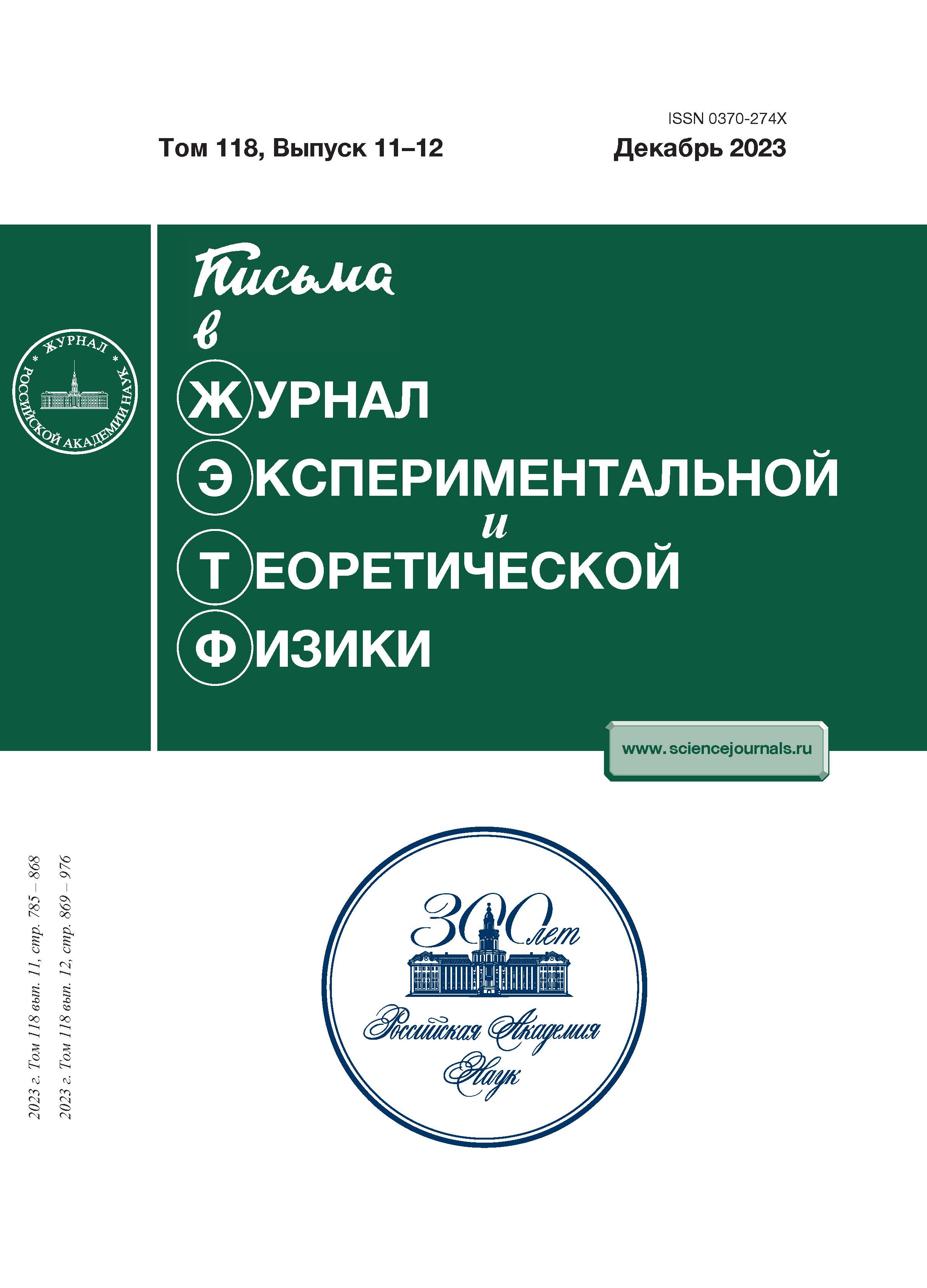Эффективное ускорение электронов фемтосекундными лазерными импульсами умеренной мощности
- Авторы: Вайс О.Е.1,2, Лобок М.Г.1,2, Соловьев А.А.3, Миронов С.Ю.3, Хазанов Е.А.3, Быченков В.Ю.1,2
-
Учреждения:
- Физический институт им. П. Н. Лебедева РАН
- ФГУП “Всероссийский научно-исследовательский институт автоматики им. Н. Л. Духова”
- Федеральный исследовательский центр Институт прикладной физики РАН
- Выпуск: Том 118, № 11-12 (12) (2023)
- Страницы: 871-876
- Раздел: Статьи
- URL: https://ter-arkhiv.ru/0370-274X/article/view/664205
- DOI: https://doi.org/10.31857/S1234567823240011
- EDN: https://elibrary.ru/OBFRVK
- ID: 664205
Цитировать
Полный текст
Аннотация
Режим релятивистского самозахвата лазерного импульса - эффективный механизм ускорения электронов, позволяющий достичь предельных значений заряда пучка высокоэнергетичных частиц и соответствующего коэффициента конверсии лазерной энергии. Показано, что в таком режиме укорочение импульса фемтосекундного лазера с использованием инновационного метода посткомпрессии CafCA [1] до предельно коротких длительностей с сохранением энергии лазерного пучка приводит к значительному повышению эффективности ускорения частиц. Данный эффект иллюстрируется на примере лазерной установки “Мультитера” для проекта, осуществляемого в рамках российского Национального Центра Физики и Математики (НЦФМ).
Об авторах
О. Е. Вайс
Физический институт им. П. Н. Лебедева РАН;ФГУП “Всероссийский научно-исследовательский институт автоматики им. Н. Л. Духова”
Email: ovais@lebedev.ru
Москва, 119991 Россия; Москва, 127030 Россия
М. Г. Лобок
Физический институт им. П. Н. Лебедева РАН;ФГУП “Всероссийский научно-исследовательский институт автоматики им. Н. Л. Духова”
Email: ovais@lebedev.ru
Москва, 119991 Россия; Москва, 127030 Россия
А. А. Соловьев
Федеральный исследовательский центр Институт прикладной физики РАН
Email: ovais@lebedev.ru
Нижний Новгород, 603950 Россия
С. Ю. Миронов
Федеральный исследовательский центр Институт прикладной физики РАН
Email: ovais@lebedev.ru
Нижний Новгород, 603950 Россия
Е. А. Хазанов
Федеральный исследовательский центр Институт прикладной физики РАН
Email: ovais@lebedev.ru
Нижний Новгород, 603950 Россия
В. Ю. Быченков
Физический институт им. П. Н. Лебедева РАН;ФГУП “Всероссийский научно-исследовательский институт автоматики им. Н. Л. Духова”
Автор, ответственный за переписку.
Email: ovais@lebedev.ru
Москва, 119991 Россия; Москва, 127030 Россия
Список литературы
- E. A. Khazanov, S. Yu. Mironov, and G. Mourou, Phys.- Uspekhi 62, 1096 (2019).
- T. Tajima and J. M. Dawson, Phys. Rev. Lett. 43, 267 (1979).
- A. Pukhov and J. Meyer-ter-Vehn, Appl. Phys. B 74, 355 (2002).
- H. T. Kim, K. H. Pae, H. J. Cha, I. J. Kim, T. J. Yu, J. H. Sung, S. K. Lee, T. M. Jeong, and J. Lee, Phys. Rev. Lett. 111, 165002 (2013).
- W. P. Leemans, A. J. Gonsalves, H.-S. Mao, K. Nakamura, C. Benedetti, C. B. Schroeder, Cs. T'oth, J. Daniels, D. E. Mittelberger, S. S. Bulanov, J.-L. Vay, C. G. R. Geddes, and E. Esarey, Phys. Rev. Lett. 113, 245002 (2014).
- A. J. Gonsalves, K. Nakamura, J. Daniels et al. (Collaboration), Phys. Rev. Lett. 122, 084801 (2019).
- V. Yu. Bychenkov, M. G. Lobok, V. F. Kovalev, and A. V. Brantov, Plasma Phys. Control. Fusion 61, 124004 (2019).
- M. G. Lobok, A. V. Brantov, and V. Yu. Bychenkov, Phys. Plasmas 26, 123107 (2019).
- V. F. Kovalev and V. Yu. Bychenkov, Phys. Rev. E 99, 043201 (2019).
- V. Yu. Bychenkov and V. F. Kovalev, Radiophys. Quantum Electron. 63, 742 (2021).
- S. V. Bulanov, F. Pegoraro, and A. M. Pukhov, Phys. Rev. Lett. 74, 710 (1995).
- В. И. Таланов, Известия ВУЗов. Радиофизика 7, 564 (1964).
- R. Y. Chiao, E. Garmire, and C. Townes, Phys. Rev. Lett. 13, 479 (1964).
- С. А. Ахманов, А. П. Сухоруков, Р. В. Хохлов, ЖЭТФ 50, 1537 (1966).
- A. B. Borisov, A. V. Borovskiy, O. B. Shiryaev, V. V. Korobkin, A. M. Prokhorov, J. C. Solem, T. S. Luk, K. Boyer, and C. K. Rhodes, Phys. Rev. A 45, 5830 (1992).
- А. Комашко, С. Мушер, С. Турицын et al. (Collaboration), Письма в ЖЭТФ 62, 849 (1995).
- В. Ю. Быченков, М. Г. Лобок, Письма в ЖЭТФ 114, 650 (2021).
- G. Mourou, S. Mironov, E. Khazanov, and A. Sergeev, Eur. Phys. J. Spec. Top. 223, 1181 (2014).
- S. Yu. Mironov, S. Fourmaux, P. Lassonde, V. N. Ginzburg, S. Payeur, J.-C. Kie er, E. A. Khazanov, and G. Mourou, Appl. Phys. Lett. 116, 241101 (2020).
- S. Mironov, P. Lassonde, J.-C. Kie er, E. Khazanov, and G. Mourou, Eur. Phys. J. Spec. Top. 223, 1175 (2014).
- Ph. Lassonde, S. Mironov, S. Fourmaux, S. Payeur, E. Khazanov, A. Sergeev, J.-C. Kie er, and G. Mourou, Laser Phys. Lett. 13, 075401 (2016).
- S. Yu. Mironov, V. N. Ginzburg, I. V. Yakovlev, A. A. Kochetkov, A. A. Shaykin, E. A. Khazanov, and G. A. Mourou, Quantum Electron. 47, 614 (2017).
- V. Ginzburg, I. Yakovlev, A. Kochetkov, A. Kuzmin, S. Mironov, I. Shaikin, A. Shaykin, E. Khazanov, Opt. Express 29, 28297 (2021).
- A. Shaykin, V. Ginzburg, I. Yakovlev, A. Kochetkov, A. Kuzmin, S. Mironov, I. Shaikin, S. Stukachev, V. Lozhkarev, A. Prokhorov, and E. Khazanov, High Power Laser Sci. Eng. 9, E54 (2021).
- A. Soloviev, A. Kotov, M. Martyanov et al. (Collaboration), Opt. Express 30, 40584 (2022).
- V. Ginzburg, I. Yakovlev, A. Zuev, A. Korobeynikova, A. Kochetkov, A. Kuzmin, S. Mironov, A. Shaykin, I. Shaikin, E. Khazanov, and G. Mourou, Phys. Rev. A 101, 013829 (2020).
- C. Nieter, J. R. Cary, J.Comput. Phys. 196, 448 (2004).
- E. Esarey, C. B. Schroeder, W. P. Leemans, Rev. Mod. Phys. 81, 1229 (2009).
- S. P. D. Mangles, G. Genoud, M. S. Bloom, M. Burza, Z. Najmudin, A. Persson, K. Svensson, A. G. R. Thomas, and C.-G. Wahlstr¨om, Phys. Rev. ST Accel. Beams 15, 011302 (2012).
- M. G. Lobok, A. V. Brantov, D. A. Gozhev, and V. Yu. Bychenkov, Plasma Phys. Control. Fusion 60, 084010 (2018).
- J. Faure, Y. Glinec, A. Pukhov, S. Kiselev, S. Gordienko, E. Lefebvre, J.-P. Rousseau, F. Burgy, and V. Malka, Nature 431, 541 (2004).
- A. Pukhov, S. Gordienko, S. Kiselev, and I. Kostyukov, Plasma Phys. Control. Fusion 46, B179 (2004).
Дополнительные файлы











